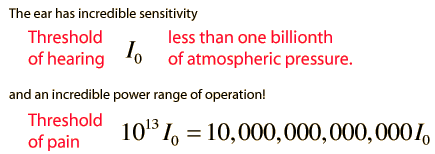Sound Intensity
Sound intensity is defined as the sound power per unit area. The usual context is the measurement of sound intensity in the air at a listener's location. The basic units are watts/m2 or watts/cm2 . Many sound intensity measurements are made relative to a standard threshold of hearing intensity I0 :

The most common approach to sound intensity measurement is to use the decibel scale:

Decibels measure the ratio of a given intensity I to the threshold of hearing intensity , so that this threshold takes the value 0 decibels (0 dB). To assess sound loudness, as distinct from an objective intensity measurement, the sensitivity of the ear must be factored in.
Sound level measurement
Loudness concepts
| HyperPhysics***** Sound | R Nave |



